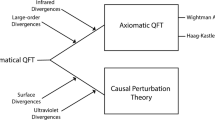Summary
Relativistic quantum mechanics with the invariant evolution parameter or historical time τ is reconsidered. The theory is obtained by quantizing the classical theory in which mass is not fixed but enters later as a constant of motion. There are no constraints among the components of the canonical momentumP μ, but the theory is still relativistic and reparametrization invariant. The Feynman propagator of a free particle is obtained in a very elegant way. The theory is then secondly quantized. The Hamiltonian for the τ-evolution is constructed and it is shown that the Heisenberg equations are identical to the field equations. The formalism is manifestly Poincaré covariant at each step and refers in general to the states with indefinite mass. On the mass shell it contains the known results of the relativistic field theory of a free charged particle.
Similar content being viewed by others
References
SeeL. P. Horwitz andF. Rohrlich:Phys. Rev. D,24, 1528 (1981);26, 3452 (1982);L. P. Horwitz:On relativistic quantum theory, inOld and New Questions in Physics, Cosmology, Philosophy and Theoretical Biology, edited byA. van der Merwe (Plenum, 1983), p. 169;L. P. Horwitz andY. Lavie:Phys. Rev. D,26, 819 (1982);J. P. Horwitz, F. C. Rotbort:Phys. Rev. D,24, 2127 (1981);R. Arshansky, L. P. Horwitz andY. Lavie:Fond. Phys.,13, 1167 (1983).
M. Henneaux andC. Teitelboim:Ann. Phys.,143, 127 (1982).
R. E. Collins andJ. R. Fanchi:Nuovo Cimento A,48, 314 (1978);A. Herdegen:Acta Phys. Pol. B,13, 863 (1982);J. Samuel:Phys. Rev. D,26, 3475, (1982);A. O. Barut andW. D. Thacker:Phys. Rev. D,31, 1386 (1985);F. Ravndal:Phys. Rev. D,21, 2823 (1980).
M. Pavšič:Nuovo Cimento A,82, 443 (1984).
E. C. G. Stueckelberg:Helv. Phys. Acta,14, 316 (1941);15, 23, 51 (1941).
The view that mass should be considered as a constant of motion is held by Barut and Zanghi in their theory of a spinning particle [7].
A. O. Barut andN. Zanghi:Phys. Rev. Lett.,52, 2009 (1984).
R. Marnelius:Acta Phys. Pol. B,13, 669 (1982);M. Pavšič:Phys. Lett. B,13, 327 (1987).
See,e.g.,A. O. Barut:Electromagnetic and Classical Theory of Fields and Particles (MacMillan, New York, N.Y., 1964):
H. Rund:The Hamilton-Jacobi Theory in the Calculus of Variations (D. van Nostrand, London, 1966).
P. A. M. Dirac:Lecture on Quantum Field Theory (University Press, New York, N.Y., 1964).
L. Brink, P. DiVecchia andP. S. Howe:Phys. Lett. B,65, 471 (1976);A. M. Polyakov:Phys. Lett. B,103, 207 (1981).
A general formalism for a field action with proper time has been considered byJ. R. Fanchi:Phys. Rev. D,20, 3108 (1979). A specific theory for a fermionic field has been given byR. Kubo:Nuovo Cimento A,85, 293 (1985).
J. R. Fanchi [13] considered only the termsT μ ν andT μ τ, but he omits the terms Θ and Θ μ . R. Kubo [13] considers also Θ, but he omits Θ μ .
The commutator (5.23) is different from zero both for timelike and spacelike intervalsx′ μ−x μ. In this theory the notion of causality is more general than usually assumed, since the evolution occurs in τ and notx 0. In any case, it seems to us that the usual requirement which forbids the interference between operators separated by spacelike distances is in disagreement with the Einstein-Podolski-Rosen paradox and its confirmation in Aspect-Rapisarda experiment [16].
A. Aspect, P. Grangier andG. Roger:Phys. Rev. Lett.,47, 460 (1981);A. Aspect, P. Grangier andG. Roger:Phys. Rev. Lett.,49, 91 (1982);A. Aspect, J. Dalibard andG. Roger:Phys. Rev. Lett.,49, 1804 (1982);A. Garuccio andV. Rapisarda andJ. P. Vigier:Lett. Nuovo Cimento,32, 451 (1981);A. Garrucio andV. Rapisarda:Nuovo Cimento A,65, 269 (1981).
In a special reference frame in whichn μ=(1,0,0,0,…) we havep μ n μ=p 0=p 0. We use the metric signature (+--- …).
Author information
Authors and Affiliations
Rights and permissions
About this article
Cite this article
Pavšič, M. Relativistic quantum mechanics and quantum field theory with invariant evolution parameter. Nuov Cim A 104, 1337–1354 (1991). https://doi.org/10.1007/BF02789576
Received:
Accepted:
Published:
Issue Date:
DOI: https://doi.org/10.1007/BF02789576



